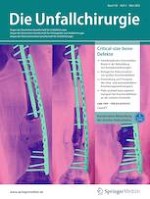Erschienen in:

28.12.2022 | Klavikulafraktur | In der Diskussion
Claviculaschaftfrakturen im Kindes- und Jugendalter
Konsensusreport der Sektion Kindertraumatologie in der Deutschen Gesellschaft für Unfallchirurgie
verfasst von:
Dr. Ilona Schubert, Katharina Moers, Francisco F. Fernandez, Jörn Zwingmann, Dorien Schneidmüller, Peter P. Schmittenbecher, Peter C. Strohm, Sektion Kindertraumatologie in der DGU
Erschienen in:
Die Unfallchirurgie
|
Ausgabe 3/2023
Einloggen, um Zugang zu erhalten
Zusammenfassung
Einleitung
Claviculaschaftfrakturen gehören zu den häufigsten Frakturen im Kindes- und Jugendalter. Früher wurden diese fast ausschließlich konservativ therapiert, in den letzten Jahren zeigte sich jedoch eine Zunahme der operativen Versorgungen. Klare Empfehlungen zur Diagnostik und zur Therapiewahl für diese Verletzung gibt es bisher nicht.
Material und Methoden
Ziel war deshalb, im Rahmen des 7. wissenschaftlichen Arbeitstreffens der Sektion für Kindertraumatologie in der Deutschen Gesellschaft für Unfallchirurgie einen Konsens auf Basis der Expertenmeinung zu erarbeiten.
Ergebnisse
Die Röntgendarstellung in einer Ebene gilt als Goldstandarddiagnostikum. Kinder unter 10 Jahren werden vornehmlich konservativ behandelt; die Art der Ruhigstellung ist zweitrangig. Bei Mädchen älter als 12 Jahre und Jungen älter als 14 Jahre sollten um mehr als Schaftbreite dislozierte und > 2 cm verkürzte Frakturen offen reponiert und osteosynthetisch stabilisiert werden, gefolgt von einer freifunktionellen Nachbehandlung.
Schlussfolgerung
Neben dem Röntgen gilt es, die Ultraschalldiagnostik weiter zu etablieren. Die Therapie erfolgt weiterhin vornehmlich konservativ, die operative Therapie hat jedoch ebenfalls einen Stellenwert, insbesondere bei Jugendlichen. Bei korrekter Indikationsstellung ist unabhängig von der Therapiewahl von einem guten Outcome auszugehen.











